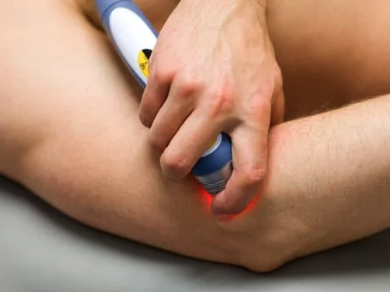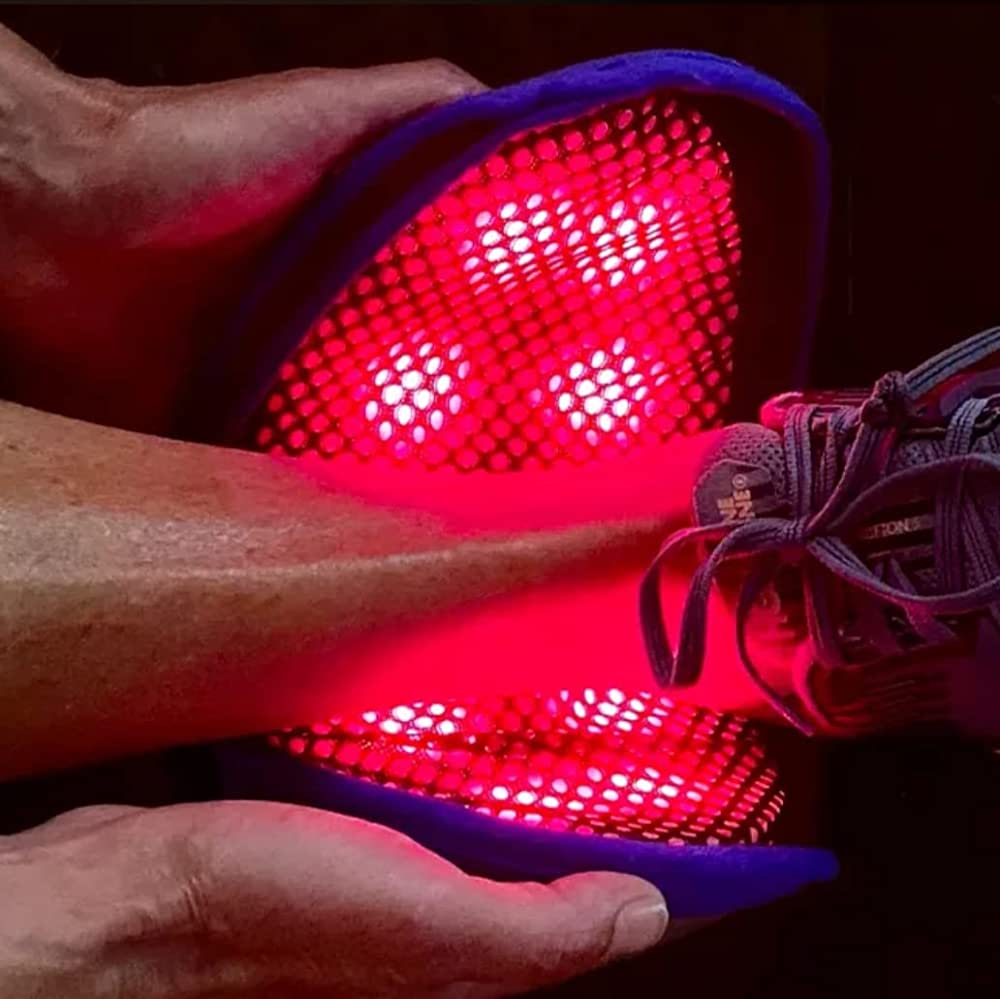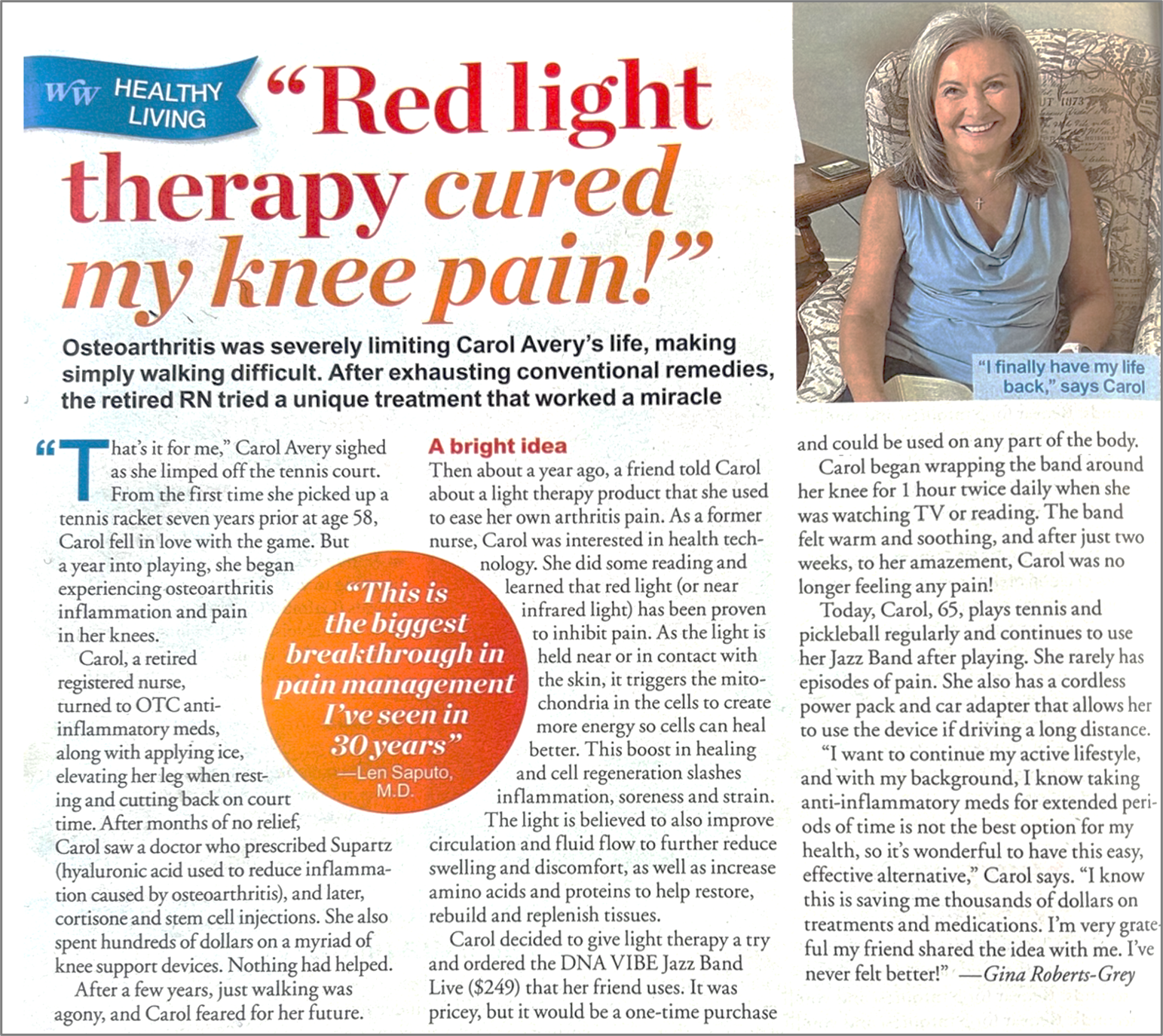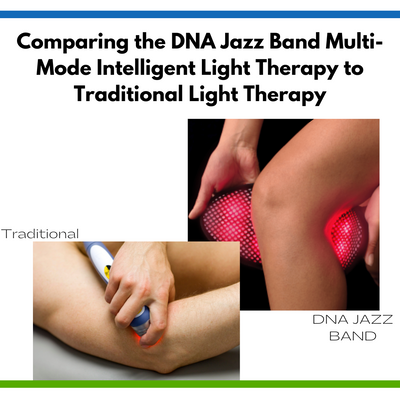 8th Feb 2023
8th Feb 2023
Comparing the DNA Jazz Band Multi-Mode Intelligent Light Therapy to Traditional Light Therapy
Traditional Light Therapy

Traditional light therapy, or red light therapy (also called laser therapy), is a treatment that touts to help skin, muscle, and other connective tissues heal by exposing them to low levels of red light (can be seen) or near-infrared light (cannot be seen) sufficient to penetrate the tissue cell’s mitochondria (the energy generators of the cell) and stimulate an enhanced production of adenosine triphosphate (ATP), or energy. This process is known as photobiomodulation (PBM).
This enhanced energy production is used to alleviate pain and inflammation, and support healing in skin, muscle, and other connective tissues through thermal and kinetic effects based on absorption and conversion of light energy only, and not through excitation .
Both sources of traditional light therapy are emitted using laser or LED therapies that submit similar wavelengths, but have differences including the power generated, the specificity of wavelength, and the physical characteristics of the beam generated from the diode. Typically, red light is associated with superficial surface skin penetration and near-infrared light with deeper tissue penetration.
- Laser: produces a smaller and more focused columnated wavelength using a specific multi-pass lasing processes to generate coherent light emissions focused on a small surface area generating greater power per square cm. This increases its ability to reach deeper tissues through increased power per unit area vs. LEDs. However, this also increases the risk of skin burn and necessitates the use of protective eye wear.
- LEDs: emits light in small band wavelengths, cannot emit a single specified wavelength, produces neither a columnated nor coherent beam, operates at a lower power (wattage) than most lasers and consequently cannot reach deeper tissues. However, LEDs attempt to mitigate this by increasing density of emitter arrays, and output per LED.
Most data indicates that these modalities only produce a “thermal” effect on the tissues – relaxing and expanding the tissues accompanied by enhanced blood flow to the area bringing some pain relief, but little by way of actual healing of the tissues.
DNA Jazz Band Multi-Mode Intelligent Light Therapy

The DNA Jazz Band is a new and revolutionary light therapy plus magnetic signaling and micro-vibrational nerve gating technology. These four modalities (red light, near-infrared light, Micro-vibration, magnetic) work together synergistically to deliver red and near-infrared light therapy at the lowest power output/intensity and optimal frequency to optimize the precision and depth of tissue penetration by:
- Red Light: Stimulating DNA excitation at the molecular level to help amplify the body’s natural regenerative processes while stimulating ATP production
- Near-Infrared Light: The appropriate frequency at the least amount of power to maximize tissue expansion and thermal effects to reduce tissue density allowing a significantly deeper penetrations of the red light therapy for optimal DNA excitation – without the potentially damaging intensity of laser or output LED arrays
- Micro-Vibration: The micro-vibrations, which are a high-frequency, low amplitude mechanical oscillation, also helps facilitate maximum penetration of low-intensity red light while also acting as a nerve-gating mechanism. Further, the micro-vibration pattern is pulsed which has a two-pronged effect: 1) prevents the mind from adapting to the micro-vibration pattern; and 2) promotes the flow of non-vascular fluid flow via fluid entrainment. Both these effects help reduce the stress enacted on inflamed tissues, helping to mitigate pain and create an environment for enhanced tissue healing
- Magnetic Signaling: The magnetic signaling also produces a mechanical action that leads to target tissue relaxation which also helps facilitate maximum penetration of the red light
What are the Effects and Benefits?
- Increase mitochondrial production of Adenosine Triphosphate (ATP ): Light therapy causes stimulation of the enzyme cytochrome c oxidase which mediates the transfer of electrons for the reduction of molecular oxygen for the production of ATP and the associated increased cellular energy, vitality, and regenerative ability
- Increase vasodilation and oxygenation: The biomodulation acts on the cell’s mitochondria causing the photodissociation of nitric oxide (NO), reversing the mitochondrial inhibition of respiration due to excessive NO binding, expanding the tissues, and increasing cellular respiration and localized vasodilation for increased blood flow to the targeted site
- Provides anti-inflammatory, pain mitigation, and cellular protective effects: Through the mechanical action of magnetic signaling and vibrational forces, pain transmission signals are interrupted, tissues expand allowing better penetration of the light therapies, edema is reduced, and reductions in inflammatory markers (ROS) and pr-inflammatory cytokines occur in stressed tissues
- Increase synthesis of ammino acids and proteins: PBM stimulates messenger RNA which increases the synthesis of amino acids and proteins to help restore, rebuild, and replenish damaged tissues. It has also been shown to potentiate muscle training responses and performance, and to promote faster muscle recovery.These modes create cellular and molecular effects leading to increased fibroblast during proliferation and subsequently increased collagen production to facilitate quicker wound contraction and tensile strength development, making a highly effective form of treatment for tissue repair
How Does the Multi-Mode Intelligent Light Therapy Technology Accomplish These Superior Physiological Effects?
In a nutshell, a better understanding of the relationship between genomics and wave-particle physics has enabled the development of the multi-mode intelligent light therapy where precision over power drives the development with:
- A high-performance dual-core intelligent micro-processor organizes the four modes and provides precision controls for optimal synchronization and maximum effectiveness
- Advanced frequency stabilization circuits work synergistically to prevent against coherent light source drift and a resulting reduction in efficacy
- Instead of increasing initial source power to force the depth of penetration, which can adversely affect safety and overwhelm the excitation effects , the patent-pending flexible flush-fit design feature of the silicon band minimizes reflection and scatter losses for more effective therapy and safety, while also providing a best-fit “versatility” and “wearability” for all body parts , thus negating the need for multiple products for the various body location applications
- Advanced micro-diffusion technology ensures an optimal distribution of the light therapy over the skin mitigating the development of hot spots and uneven, less efficacious application
- Patent-pending silicone band construction also serves as a highly efficient medium for propagation of mechanical (vibrational) energy, allowing the micro-vibration to be evenly distributed across the entire face of the pad
A Final Word on Wearability, Versatility and Affordability
The flexible flush-fit design feature of the Jazz Bands, their dual different size elastic securement bands, and the interchangeable power options (wall plug in adapter, car adapter, and cordless power pack) allow the Jazz Band to be worn (and therapy delivered) on any body part, anytime and anywhere – including a fully submersible Jazz Band), and at a very affordable cost.
CLICK HERE to see the article, “Buyers and Users Guide to the DNA Jazz Band
|
Jazz Band LIVE
|
Jazz Band VIBE
|
Jazz Band Splash
|
Enjoy reading this editorial feature on the DNA Jazz Band in
the February 2023 issue of
Woman’s World magazine.






